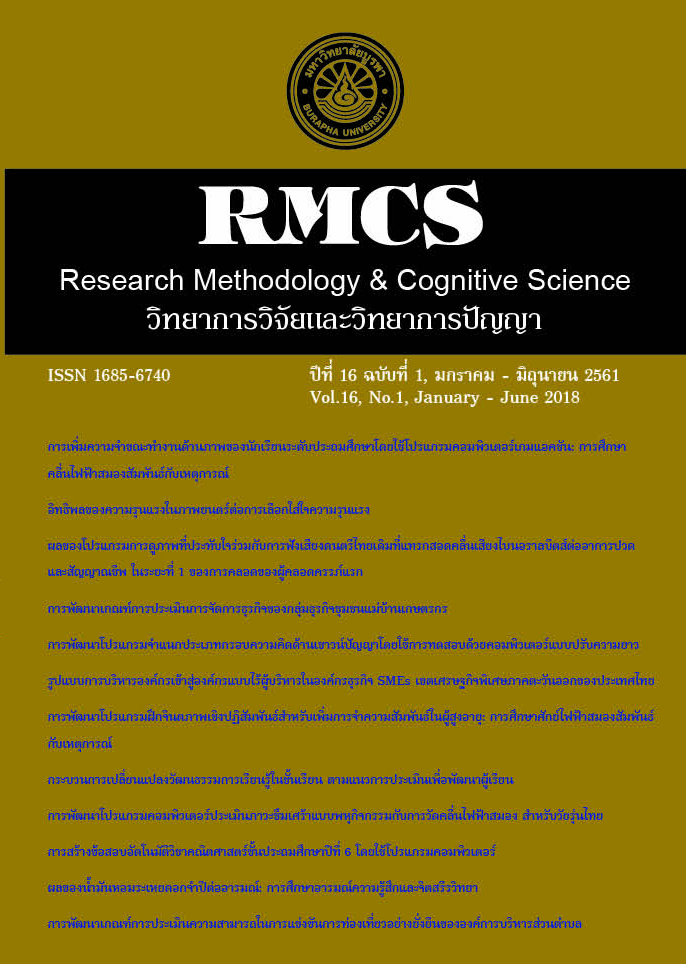Effect of Violent in Film on Selective Attention toward Violence
Main Article Content
Abstract
The purpose of the experiment was to examine effect of violent in film on selective attention toward violence, measured by a reaction time task. The participants were divided into 2 groups: watching either violent or non-violent film. Then they were exposed to violent and non-violent images for a brief period, followed by a dot. The task was to press a button to identify the location of a dot whether appeared after either a violent or a non-violent image. The reaction time was recorded by E-prime program (version 2.0), then analyzed by mixed factorial ANOVA (2x2). The finding revealed that the violent-film group responded to the dot appeared after the violent image faster than one after non-violent image at significant level 0.05. This implied the effect of violent film on a selective attention, which is explained by priming effect and mental model.
Article Details
References
Bryant, J., & Zillmann, D. (2002). Media effects: advances in theory and research. Mahwah, New jersey: L. Elbaum Associates.
Bushman, B. J. (1998). Priming effects of media violence on the accessibility of aggressive constructs in memory. Personality and Social Psychology Bulletin, 24(5), 537-545.
Bushman, B. J., & Geen, R. G. (1990). Role of cognitiveemotional mediators and individual differences in the effects of media violence on aggression. Journal of Personality and Social Psychology, 58(1), 156-163.
Fenigstein, A. (1979). Does aggression cause a preference for viewing media violence?. Journal of Personality and Social Psychology, 37(12), 2307-2317.
Field, A. (2009). Discovering statistics using SPSS(3rd ed.). London: Sage.
Forrester, J. W. (1971). Counterintuitive behavior of social systems. Technological Forecasting and Social Change, 73(3), 52-68.
Intaraprasert, S. (2014). The Relationship between Media Influence and Violent Behavior of Child and Youth in Bangkok.(Master Thesis). Suan
Dusit Rajabhat University, Faculty of Management Science. (In Thai)
Josephson, W. L. (1987). Television violence and children’s aggression: Testing the priming, social script, and disinhibition predictions. Journal of Personality and Social Psychology, 53(5), 882-890.
Office of The National Broadcasting and Telecommunications Commission. (1 September 2013). How does media affect society?. Retrieved from http://bcp.nbtc.go.th/knowledge/detail/324 (In Thai)
Park, Y., & Raney, A. A. (presented 2006). Exploring the priming effect of violent video games on subsequent media content selection. Paper presented at the meeting of International Communication Association, Dresden, Germany. (International).
Radvansky, G. A., & Zacks, R. T. (1997). The retrieval of situation-specific information. Cognitive Models of Memory, 173-213.
Rangsipol, N. (2014). Study of intertextuality through the movies : the Letter and Jod Mai Ruk. (Master Thesis). Thammasat University, Faculty of Journalism
and Mass Communication. (In Thai)
Schmadeke, S. (2015, June 4). UIC student cleared in ‘Fifty Shades of Grey’ case back in criminal court. Chicago Tribune. Retrieved from http://
www.chicagotribune.com/news/ct-50-shadesof-grey-uic-sex-charge-met-20150603-story.html
Sparks, G. G. (2006). Media effects research: A basic overview. Belmont, California: Wadsworth.
Tulving, E., & Schacter, D. (1990). Priming and human memory systems. Science, 247(4940), 301-306.
Tulving, E., Schacter, D. L., & Stark, H. A. (1982). Priming effects in word-fragment completion are independent of recognition memory. Journal of Experimental Psychology, 8(4), 336-342.
Wyer Jr, R. S., & Radvansky, G. A. (1999). The comprehension and validation of social information. Psychological Review, 106(1), 89-118.

